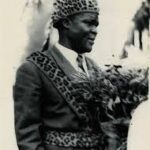KADALIE, CLEMENT
- 5 Min Read
Clement Kadalie (circa 1896-November 28, 1951) was the founder and leader of the Industrial and Commercial Workers’ Union of Africa, popularly known as the ICU.

PHOTO CAPTION: Clement Kadalie SOURCE: EA Library
A gifted orator and a leader of immense ability and audacity, Kadalie in the 1920s built the ICU into the first modern mass movement of blacks in southern Africa. At the height of his career, he attracted much attention from whites as well as blacks, even at times, as in the election of 1924, thrusting the ICU into the arena of white politics.
Kadalie’s success in drawing together Africans of different ethnic backgrounds was in part due to his foreign birth and consequent lack of affiliation with any single South African language group. He was born in Nyasaland (now Malawi), near the Bandawe mission in or shortly before 1896. (“Clements Kadalie” was his adopted name; his original name was Lameck Koniwaka Kadali Muwamba).
His paternal grandfather, Chiweyu, was the paramount chief of the Atongas. Kadalie’s father died in 1904, and his education was thereafter overseen by his uncle, Alick Banda, who was a brother of Hastings Banda, the later president of Malawi.
In 1912 Kadalie completed his secondary schooling at Livingstonia Missionary Institute, qualifying as a teacher. He taught for only one year, then set out to see the world, working as a clerk in a succession of jobs in Portuguese East Africa (now Mozambique) and Southern Rhodesia (now Zimbabwe). Early in 1918, he arrived in Cape Town, where his older brother was then employed.
A chance meeting and friendship with a socialist candidate for parliament, A.F. Batty, led Kadalie to the idea of launching a trade union, and in January 1919 the ICU was founded in Cape Town with an initial membership of 24, most of whom were Coloured dock workers. Following a partially successful dock strike a year later, an attempt was made to deport Kadalie, but he called influential friends to his aid, and the deportation order was canceled.
At a coordinating conference of black trade unionists at Bloemfontein in July 1920, Selby Msimang, a founder member of the African National Congress (ANC), was elected to head the expanding ICU. Kadalie, who had hoped to control the new organisation, retreated to his base in the Cape. The following year he successfully challenged Msimang’s leadership and was elected the union’s national secretary, a position he held until the ICUs disintegration in 1929.
Wartime rises in the cost of living had led to widespread worker dissatisfaction, and the ICU spread, in the words of Edward Roux, “like a veld fire over the Union.” After two years of consolidating the ICU in the Cape, Kadalie and his lieutenants were able to expand the union in Natal, the Free State, the Transvaal, and even in surrounding countries, until in 1927-28, the organisation could claim a membership of more than 100,000. For five years, beginning in 1923, Kadalie edited a union newspaper, the Workers’ Herald.
In 1924 Kadalie came out for the Nationalist-Labour coalition against Prime Minister Jan Christian Smuts, urging African voters to back J.B.M. Hertzog. Although this venture into politics received wide publicity, it was based on a miscalculation, since the coalition government proved as anti-black as its predecessor. In another controversial maneuver in 1326, Kadalie backed the expulsion of communists from the ICU. Though sometimes eclectic in his search for allies, Kadalie was consistent in trying to win recognition for the ICU as a legitimate union.
When all efforts failed to win acceptance for the ICU by white-led unions in South Africa, Kadalie carried his quest abroad, and in 1927 he traveled to Geneva as an unofficial delegate to a conference of the ILO. For five months he toured Europe, lecturing to sympathetic audiences.
Through Arthur Creech-Jones and other contacts in the British labor movement, Kadalie secured a promise of assistance for the ICU in the form of an advisor. When the advisor, William Ballinger, arrived in South Africa in 1928, his relations with Kadalie soon soured.
Rivalries and financial misdealings were already destroying the ICU from within. Natal had split away under A.W.G. Champion, and the new “hostility clause” in the Native Administration Act of 1927 was threatening the union’s ability to maintain its popularity through militant rhetoric. Kadalie himself was charged under the act in 1928 but was acquitted in one of the ICUs best-known court victories.
Under the pressure of heavy criticism, Kadalie resigned in early 1929 as ICU secretary but two weeks later tried to reassert his leadership and oust his critics, who had come together around Ballinger. This failed, and in March 1929 Kadalie formed the “Independent ICU.”
By the end of 1929, however, he had reestablished an organised following only in East London, where in 1930 he organized a major general strike. Though Kadalie failed to revive the ICU nationally, he continued to participate in national affairs as a member of the African National Congress in the 1930s and 1940s.
Kadalie was a complex figure and his public actions seldom failed to arouse controversy. In a society where advanced age was usually a prerequisite for leadership, he achieved his meteoric rise as a very young man. In his private dealings, he was vain and susceptible to flattery; in his public life, he radiated self-assurance.
While white liberal sympathisers whose advice Kadalie alternately courted and spurned often considered him dangerously radical, radicals such as Roux condemned him as a cautious conservative masquerading behind a screen of demagogic oratory.
It can be argued that, for all its popularity, the ICU won few advances for its members. Yet Kadalie’s achievements should not be underestimated, for as a movement, the ICU attracted a broader following of rural and urban workers, including Coloureds and Indians as well as Africans, than any organisation up to that time and for several decades thereafter. Kadalie died in East London in 1951.
GAIL M. GERHART




